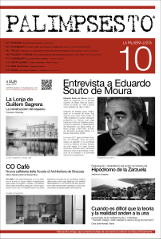The journey and the architect
DOI:
https://doi.org/10.5821/palimpsesto.10.3656Keywords:
Le Corbusier, Ineffable space, MemoryAbstract
Throughout history, architectural education has been accompaniedby the journey. The “grand tour” served initially to completethe knowledge of history and composition, but at thesame time constituted a source of experiences that will accompanythe architect throughout his life and work. The veryact of traveling involves a relocation, a tabula rasa on whichthe senses are awakened and intensified, making the subjecta sensitive resonance box that allows a deep assimilation ofthe perceived experiences that feeds his imaginary. Perception,memory and imagination are inextricably linked. Sincethe architect has an innate ability to remember and imaginespaces, the journey is a source of experiences and emotionsthat shape memory.
Le Corbusier’s work is marked by his travels. One can definehis architecture, painting and sculpture through his visits to Algiers,Rio de Janeiro, New York, India and Italy. But if there isone that best synthesizes all of them maybe that’s the Voyageà Orient in 1911, and primarily the visit to the Acropolis ofAthens. Le Corbusier defined the Parthenon as a machine tomove and served, years later, to define the concept of “ineffablespace”, top of the plastic emotion.
The article attempts to show how the architecture of Le Corbusierwas affected by the visit to the Parthenon, analyzing hisexperience and the evolution of the memory of it throughouthis life.
Downloads
Published
Issue
Section
License
PROTECTION AND INTELLECTUAL PROPERTY CRITERIA
Authors whose work is published in en Palimpsesto agree to the following terms:
1. The author retains the copyrights and guarantees the magazine the right to apply a Creative Commons Attribution-NonCommercial-NoDerivatives (CC BY-NC-ND), which permits others to share the work with acknowledgement of authorship.
2. The author may establish additional agreements of his or her own accord for non-exclusive distribution of the article published in the magazine (for example, in an institutional repository, or published in a book).
3. Electronic distribution of the work by the author(s) is permitted and encouraged (for example, in institutional repositories or on the author’s own website), prior to, and during the submission process, as this can generate productive exchanges, as well as earlier and greater citation of the published works (see The Effect of Open Access) (in English).
4. The author or provider of the material submitted for publication authorizes Palimpsesto to publish, with no obligation whatsoever (financial or otherwise) to the content of said material, be it in paper or digital format, or in any other medium.
5. The author or provider guarantees that he or she is the owner of the Intellectual Property rights to the contents provided, which encompasses the text and images/photographs/photographic works incorporated in the article.
6. The author or provider, exempts Palimpsesto magazine of all and any responsibility relating to violation of copyrights, thereby committing himself or herself to undertaking all efforts to assist Palimpsesto magazine in defence of any accusation, extra-judiciary, and/or judicial measures. Likewise, the author or provider will assume payment to Palimpsesto of any sum or compensation that must be paid to third parties for failure to comply with these obligations, be it the result of judicial, arbitrary or administrative decisions.
7. The submission of the texts by authors implies automatically a declaration of non plagiarism of its contents







